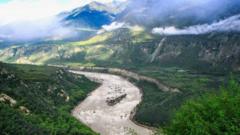China's plan to construct the Yarlung Tsangpo dam, poised to become the world's largest hydropower facility, garners mixed reactions as concerns about local displacement and environmental impacts mount. The project could dramatically alter regional dynamics, particularly concerning India and Bangladesh.
China to Develop World’s Largest Hydropower Dam in Tibet: Concerns Froth Amid Promises

China to Develop World’s Largest Hydropower Dam in Tibet: Concerns Froth Amid Promises
The ambitious Yarlung Tsangpo dam project aims for tremendous energy generation but raises significant environmental and humanitarian issues across borders.
China has recently greenlit the construction of the Yarlung Tsangpo dam, which is touted to become the largest hydropower facility globally, promising to generate three times the energy of the current largest, the Three Gorges Dam. Located within the lower reaches of the Yarlung Tsangpo River in Tibet, this ambitious undertaking has raised alarms regarding potential community displacements and environmental degradation affecting neighboring nations, particularly India and Bangladesh.
Chinese government outlets emphasize the project’s alignment with ecological preservation goals and its expected benefits for local populations and climate initiatives. Yet, human rights advocates express profound concerns over the implications the project may hold. There is mounting apprehension regarding displacement, with a history of state-sponsored relocations resonating particularly within Tibet, a region experiencing stringent governance by Beijing since its annexation in the 1950s.
Prior projects have seen community backlash met with severe crackdowns, highlighted by recent protests against a separate hydropower initiative in the area. Activists recount violent responses from authorities and the displacement of entire villages, igniting a debate over the ethical ramifications of such developments.
Chinese officials assure that the Yarlung Tsangpo project will manage its environmental footprint adequately but have not clarified the projected number of individuals impacted. Comparatively, the construction of the Three Gorges Dam necessitated resettling approximately 1.4 million people, prompting skepticism about forthcoming government transparency.
Aside from local human rights issues, experts have flagged geopolitical ramifications of China's river management. Observations suggest the dam could bolster China's capacity to control water flows from the Yarlung Tsangpo into India, which could have severe implications for regional economies, particularly in northeastern Indian states like Arunachal Pradesh and Assam. This factor has prompted India to consider counter-projects to mitigate potential adverse impacts.
The engineering feat faces its own challenges, situated in an earthquake-prone zone that heightens the risk of landslides during the construction phase. Concerns from experts indicate that significant excavations could amplify the chances of geological instability.
Financial projections for the complete undertaking hover around a staggering trillion yuan (approximately $127 billion), pointing toward the enormity of its implications, both environmentally and economically. As China pushes forward with its hydropower ambitions, the world watches closely as the multifaceted impacts of this significant developmental endeavor unfold.






















